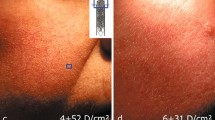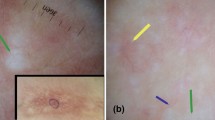Abstract
In the present study we evaluated, in involved and clinically uninvolved skin of Rosacea, microvessels density (MVD) and total vascular area (TVA) in addition to multiple morphologic characteristics of microvessels and also mast cells (MCs) number. We examined also the relationship between angiogenesis, MCs number and disease clinicopathological data. The study included 69 patients with Rosacea. A skin biopsy with a 4-mm punch was performed from clinically involved skin in each case. In nine randomly selected patients, facial biopsy specimens were obtained from both involved and clinically uninvolved skin. Histological sections, immunostained for factor VIII, were evaluated by image analysis for the quantification of MVD, TVA and several morphometric parameters related to the vessel size or shape. MCs detection in the dermis was carried out using the chloracetate esterase method (Fast Blue RR) in parafin sections. Serum antibodies against H.pylori were detected. Statistically important differences concerning the factors of angiogenesis between lesional and clinically non-lesional skin were demonstrated. A statistical important correlation was found also between high vascular density, PPR clinical type and the presence of ocular manifestations. MVD or TVA showed no correlation with the degree of solar elastosis or inflammation and with the Demodex density as well. However, high MVD values were found to correlate with granuloma formation in the dermis. MCs number were significantly greater in lesional compared to clinically non-lesional skin. Statistical significance was shown between MCs density and disease duration. However, no correlation between MCs number and blood vessel density was found. Angiogenesis seems to play an important role in the pathogenesis especially of the more severe clinical form of Rosacea. MCs seem to participate in evolution to disease chronicity by contributing to inflammation, angiogenesis and tissue fibrosis.






Similar content being viewed by others
References
Aloi F, Tomasini C (2000) The clinicopathologic spectrum of rhinophyma. J Am Acad Dermatol 42:468–472
Aroni K, Tsagroni E, Lazaris A, Patsuris E, Agapitos E (2004) Rosacea: a clinicopathological approach. Dermatology 209:177–182
Artuc M, Hermes B, Steckelings UM (1999) Mast cells and their mediators in cutaneous wound healing-active participants or innocent bystanders? Exp Dermatol 8:1–16
Ballaun C, Weninger W (1995) Human Keratinocytes express the three major splice forms of VEGF. J Invest Dermatol 104:7–10
Bamford J (2001) Rosacea: current thoughts on origin. Sem Cut Med Surg 20(3):199–206
Bancroft JD, Stevens A (1982) Theory and practice of histological techniques, 2nd edn. Churchill Livingstone, Edinburgh, p 402
Barton SP, Abdullah MS, Marks R (1992) Quantification of microvascular changes in the skin in patients with psoriasis. Br J Dermatol 126:569–574
Bielauberg DR, Sanchez R (1998) Molecular regulation of UVB-induced cutaneous angiogenesis. J Invest Dermatol 111:864–872
Bonnar A, Eustace P (1993) The Demodex mite population in Rosacea. JAAD 28:443–448
Brown LF, Harrist TJ, Yeo KT, Stable-Backdahl M, Jackman RW, Berse B, Tognazzi K, Dvorak HF, Detmar M (1995) Increased expression of VPF in bullous pemphigoid, dermatitis herpetiformis and erythema multiform. J Invest Dermatol 104:744–749
Clauss M, Gerlach M, et al (1990) VPF: a tumor derived polypeptide that induces endothelial cell and monocyte procoagulant activity and promotes monocyte migration. J Exp Med 172:1535–1545
Crawford GH, Pelle MT (2004) Rosacea I. Etiology, pathogenesis and subtype classification. JAAD 51:327–341
Detmar M (1996) Molecular regulation of angiogenesis in the skin. J Invest Dermatol 106:207–208
Erbagci Z, Ozgoztasi O (1998) The significance of Demodex folliculorum density in rosacea. Int J Dermatol 37:421–425
Folkman J (1995) Clinical applications of research on angiogenesis. N Engl J Med 333:1757–1763
Forton F, Seys B (1993) Density of Demodex folliculorum in Rosacea:a case-control study using standardized skin-surface biopsy. Br J Dermatol 128:650–659
Georgala S, Katoulis AC (2001) Increased density of Demodex folliculorum and evidence of delayed hypersensitivity reaction in subjects with papulopustular rosacea. JEADV 15:441–444
Gruber LB, Marchese JM, Kew R (1995) Angiogenic factors stimulate Mast-cell migration. Blood 86(7):2488–2493
Hagiwara K, Khaskhely MN, Vezato H, Nonaka S (199) Mast cell “Densities” in vascular proliferations: a preliminary study of pyogenic granuloma, Portwine stain, Cavernous Hemangioma, Cherry Angioma, Kaposi’s Sarcoma and Malignant Hemangioendothelioma. J Dermatol 26:577–586
Jiang YW, Chattedee DA, Raychaudhuri PS (2001) Mast cell density and IL-8 expression in nonlesional and lesional psoriatic skin. Int J Dermatol 40:699–703
Katz AM (1998) Rosacea: epidemiology and pathogenesis. J Cut Med Surg 2(Suppl4):S4–S10
Kessler AD, Lauger SR, Pless AN, Folkman S (1976) Mast cell and tumor angiogenesis. Int J Cancer 18:703–709
Kosmadaki MG (2003) UV induces VEGF through a TNF-a independent pathway. FASEB J 17:446–448
Leek RD, Hunt NC, et al (2000) Macrophage infiltration is associated with VEGF and EGFR expression in breast cancer. J Pathol 190(4):430–436
Meininger CJ, Zetter BR, et al (1992) Mast cells and angiogenesis. Semin Cancer Biol 3:73–77
Motley RJ, Banton S, Marks R (1989) The significance of telangiectasia in rosacea. In: Marks R, Plewig G (eds) Acne and related disorders. Martin Dunitz, London, pp 339–344
Neumman E, Frithz A (1998) Capillaropathy and Capillaroneogenesis in the pathogenesis of Rosacea. Int J Dermatol 37:263–266
Ono M, Torisu H (1999) Biological impliations of macrophage infiltration in human tumor angiogenesis. Cancer Chemother Pharmacol 43:S69–S71
Rothe JM, Nowak M, Kerdel AF (1990) The mast cell in health and disease. JAAD 23(4):615–624
Shea RC, Prieto GV (1994) Mast cells in angiolipomas and hemangiomas of human skin: are they important for angiogenesis? J Cut Pathol 21:247–251
Smith JR, Lanier VB (2007) Expression of VEGF and its receptors in rosacea. Br J Ophthalmol 91:226–229
Tope WD, Sangueza OP (1994) Rhinophyma’s fibrous variant histopathology and immunohistochemistry. Am J Dermatopathol 16(3):307–310
Walton S, DeSouza JE (1983) Variation in mast cell numbers in psoriasis and lichen planus: comparisons with normal skin. Dermatologica 166:236–239
Weber S, Kruger-Krasagakes S, Grabbe J (1995) Mast cells. Int J Dermatol 34(1):1–10
Wilkin J, Dahl M (2002) Standard classification of rosacea: report of the national Rosacea society expert committee on the classification and staging of Rosacea. JAAD 46:584–587
Wilkin J (1994) Rosacea. Pathophysiology and treatment. Arch Dermatol 130:359–362
Author information
Authors and Affiliations
Corresponding author
Rights and permissions
About this article
Cite this article
Aroni, K., Tsagroni, E., Kavantzas, N. et al. A study of the pathogenesis of Rosacea: how angiogenesis and mast cells may participate in a complex multifactorial process. Arch Dermatol Res 300, 125–131 (2008). https://doi.org/10.1007/s00403-007-0816-z
Received:
Revised:
Accepted:
Published:
Issue Date:
DOI: https://doi.org/10.1007/s00403-007-0816-z




